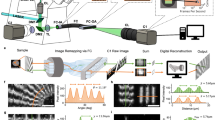Abstract
SECONDARY electrons, generated by X-rays, have been used for producing shadow images of very thin specimens (Trillat1, Tasker and Towers2). The use of other radiations (except X-rays), for example, alpha-and beta-rays, recoil atoms and accelerated ions for similar purposes does not seem to have been described. The rapidly increasing availability of radioactive nuclides makes the field very promising. A brief description of radiography with beta rays, for short 'beta radiography' is given below. A report on 'alpha radiography' experiments in this laboratory will be published shortly.
This is a preview of subscription content, access via your institution
Access options
Subscribe to this journal
Receive 51 print issues and online access
$199.00 per year
only $3.90 per issue
Buy this article
- Purchase on Springer Link
- Instant access to full article PDF
Prices may be subject to local taxes which are calculated during checkout
Similar content being viewed by others
References
Rev. Sci., 8, 364 (1942). J. App. Phys., 19, 844 (1948).
Nature, 156, 50 (1945).
Author information
Authors and Affiliations
Rights and permissions
About this article
Cite this article
Westermark, T. Radiography with Beta-Rays. Nature 164, 1086–1087 (1949). https://doi.org/10.1038/1641086a0
Issue Date:
DOI: https://doi.org/10.1038/1641086a0
Comments
By submitting a comment you agree to abide by our Terms and Community Guidelines. If you find something abusive or that does not comply with our terms or guidelines please flag it as inappropriate.



